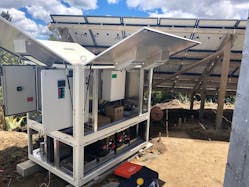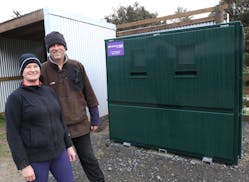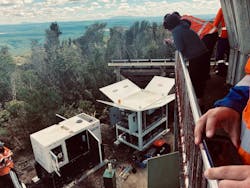A standalone power system
Base Power is a hands-off system, combining renewable solid-state generation, peak generation and intelligent storage. A remote, rural customer receives the same or better supply from Base Power as they do from traditional lines service. However, as they remain a ‘network customer’, they continue to receive services such as fault response and inquiry support from Powerco.
Base Power intelligently manages generation and storage based on customer demands, without the need for customer or external management. The core energy storage unit which houses the intelligence can act as a standalone off-grid unit, grid-connected uninterruptable power supply, or be used for peak smoothing. It has also been used as a rapid response unit after storm events on Powerco’s network.
The core energy storage unit is designed to accommodate several energy demand scenarios via the single chassis design. The key benefit of this is that is enables a customer (or supply agent) to customise and configure the unit as demand needs change. The chassis, which stands less than 2-m (6.56-ft) tall, has a footprint of 2 m X 1.5 m (4.92 ft) and weighs up to a metric tonne (1000 kg). The design of the chassis has been optimised to support easy maintenance and deployment using various methods (inducing top and bottom loading).
The unit is capable of both single and three-phase supply and supports either AC 230 V or DC 48 V power needs. It can supply at a continuous 12 kW and is capable of supporting a 19 kW peak. Storage for the solution can range from 3 kWh to 54 kWh without the need for any customization, and is capable of full daily cycling. It can be remotely monitored via various communications methods and can operate autonomously of any external input. It can be paired with a wide array of renewable and non-renewable generation to accommodate various deployment needs.
A remote, rural customer receives the same or better supply from Base Power as he does from traditional lines service. But as a ‘network customer’, he continues to receive services such as fault response and inquiry support from Powerco.
Need for a viable supply alternative
Overhead power lines and poles span miles of remote, rural, undulating countryside, and are at the mercy of high winds, slips, floods, falling trees and snow storms.
Powerco’s electricity network covers large geographical areas of New Zealand’s North Island, with many thousands of kilometers of poles and lines located in remote countryside. Powerco also has a fair share of storms, putting the resilience of the network regularly to the test.
These challenges have enabled Powerco to appreciate the complexities electricity utilities can have in keeping the power on for customers, particularly in remote areas. It led us to develop Base Power — Powerco’s standalone power system (SAPS) — as a viable supply alternative to traditional overhead lines.
Powerco customers Hans and Michelle Brink, whose 700-hectare sheep, cattle and forestry property is 50 km (31.1 mile) inland from Kai Iwi on the North Island’s west coast, know only too well the perils of living in the middle of nowhere.
Like the vast majority of New Zealand farmers, the Brinks relied on traditional poles and lines crossing land prone to slips, floods, and falling trees to provide them with the power they needed to run their business. This meant electricity supplies could be disrupted without warning — especially in bad weather and sometimes for up to two weeks — as the network was accessed and repaired following storm damage.
“When you’re at the end of the line like we were, you’re at the mercy of the whole grid,” Hans says.
But the Brinks’ electricity worries ended in mid-2015, following the worst flooding on record in the Taranaki and Manawatu-Whanganui areas, when Powerco introduced them to the original trial version of Base Power. They have since upgraded to a newer model.
Powered by photovoltaic solar panels, with a diesel generator back-up and a bank of batteries to store excess energy, the Brinks are now able to reliably operate their home and five-stand woolshed, without the worry of prolonged power cuts.
Not having to worry about electricity has been liberating, the couple say. “We don’t even think about power anymore. It’s excellent. We’re 100% happy.”
The birth of Base Power
Most of Powerco’s network was built in the 1950s and 1960s. At the time, about 1600 km (994.2 mile) of remote, rural line was constructed with the assistance of New Zealand’s Rural Electrical Reticulation Council funding. Under the New Zealand Electricity Act, distribution networks are required to still maintain supply to these remote rural customers regardless of the ability to directly recover renewal costs.
In 2008, Powerco set out to address this issue through research and innovation. After several years of testing and refinement, the utility finished development of Base Power, the all-in-one unit that provides grid-parity supply for customer installations.
Base Power provides Powerco an alternative electricity supply for areas where to upgrade the electricity network and improve supply is not cost effective. So far, Powerco has 17 Base Power units deployed on our network with an additional 60 sites planned during the next five years.
The units have proved invaluable following large storm events in our distribution area. As they are easily transportable by truck or helicopter, Powerco has been able to quickly power-up very remote customers whose power has been cut because of damage on their local lines network. In 2017, Powerco’s network was exposed to severe icing conditions resulting in significant low voltage network damage in remote areas. Eight Base Power units were deployed within 24 hours of the event and reduced pressure on recovery efforts.
Powerco has received encouraging feedback from remote customers who have been given the opportunity to have a Base Power unit provide their electricity instead of traditional overhead lines. Apart from the Brinks, Powerco has had other customers say they have experienced significant improvements in the quality and reliability of their energy supply with Base Power. In one instance, a customer who had been given a unit following a storm, asked Powerco to leave Base Power on site rather than repair and reconnect the lines.
Solution for uneconomic or risky electricity networks
Given the fact that Powerco is a utility company, Base Power was designed with other utilities in mind. As a turnkey solution, it needs minimal ongoing maintenance and, given its modular design, reduces the dependency on highly skilled field staff for second-level support.
For utilities, Base Power is an ideal solution to mitigate remote area power supply challenges in cases where networks are:
- Uneconomical to maintain or renew
- Challenged through vegetation encroachment or fire risk
- Difficult to access
- Need temporary or intermittent energy supply.
Base Power’s modular design enables utilities to easily configure it as needed — to suit a wide range of customer connection requirements without needing to customise or re-design.
With a single chassis design and standardised wiring, the unit can support different demand needs by simply adding inverters or batteries. In so doing, Base Power can support up to three-phase energy needs with 56 kWh of storage. This capability can be further extended through the unit’s ability to accept any form of renewable or backup generation. This flexibility provides utility planning engineers the confidence that, even with minimal understanding of energy demands at their target site, Base Power can be easily slotted in as the solution of choice.
A robust SAPS such as Base Power allows planners to re-think how networks are designed and renewed in remote areas. Costly, uneconomic sections of network can continue to receive grid-quality supply without the needs to maintain or rebuild using traditional methods. These types of solutions provide asset managers more flexibility in how they consider energy systems and allows more efficient allocation of annual Capex budgets.





